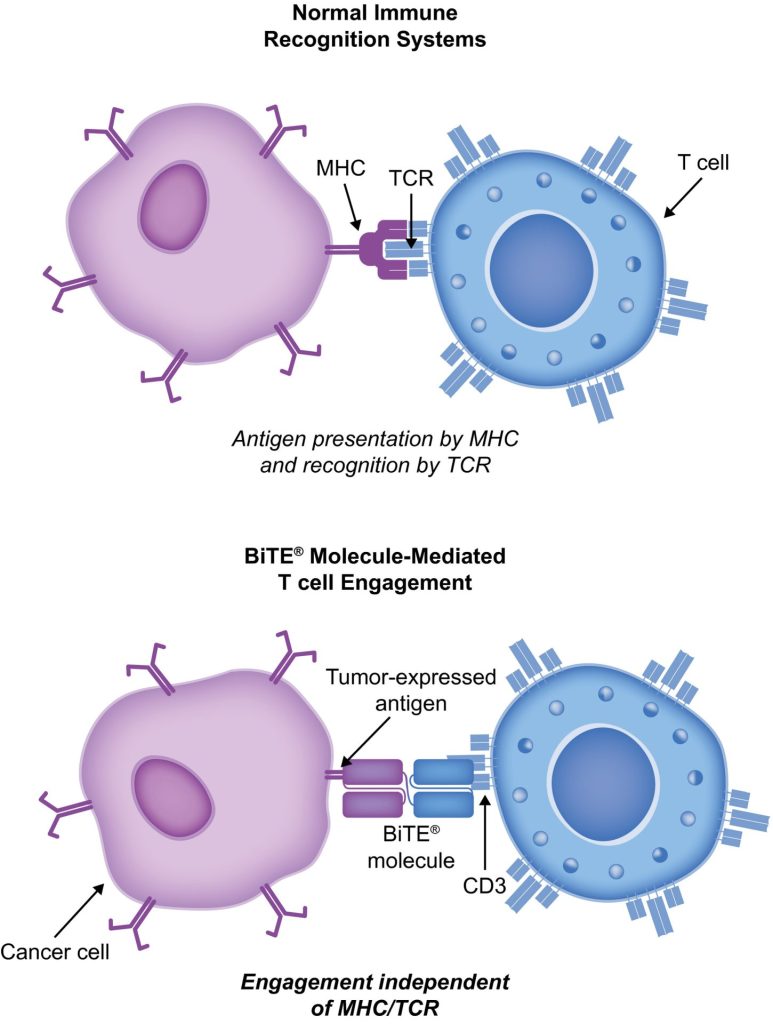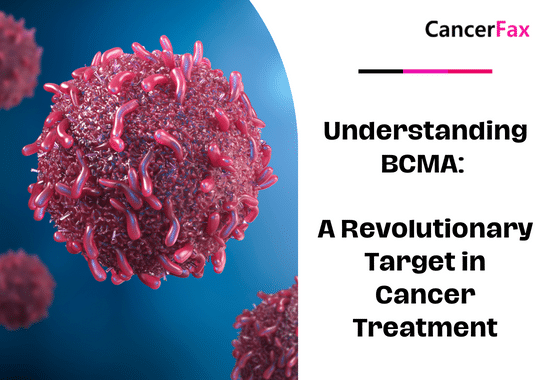Immuno-oncology is a way to treat cancer by using the body’s immune system. BiTE (bispecific T-cell engager) technology is a targeted immuno-oncology platform that binds a patient’s own T cells to cancer cells. Because BiTE technology is flexible, it is easy to make molecules that attack tumor-specific antigens, which makes immuno-oncotherapy possible. Blinatumomab was the first standard BiTE molecule to be approved. It targets CD19 surface antigens on B cells and is mostly unaffected by genetic changes or escape mechanisms inside cells. More BiTE molecules are being made to treat other blood cancers (like multiple myeloma, acute myeloid leukaemia, and B-cell හොඩ්ග්කින් නොවන ලිම්ෆෝමා) and solid tumours (like prostate cancer, glioblastoma, stomach cancer, and small-cell lung cancer). BiTE molecules that have a longer half-life than the standard ones are also being made. With BiTE technology, advances in immuno-oncology could make it easier to treat both blood and solid tumours and make them more effective when used with other treatments.
BiTe චිකිත්සාව යනු කුමක්ද?
Immuno-oncology therapies are scientifically proven ways to treat different types of solid and රුධිර පිළිකා. Hematologic cancers are a good fit for treatments that target the immune system because cancerous blood cells move around with immune cells. Several immunotherapy පිළිකා සඳහා ප්රතිකාර ක්රියාත්මක වෙමින් පවතී.
Monoclonal antibody checkpoint inhibitors that stop the binding of checkpoint proteins (like PD-1 and CTLA-4) are useful against many types of cancer. They work well and are safe for many solid tumours, especially when they target PD-1. Non-small-cell lung, kidney, and bladder cancers have all been treated successfully with these drugs. But many people don’t react to checkpoint inhibitors or get sick again after taking them. Except for non-Hodgkin ලිම්ෆෝමා, most results on hematologic cancers have been disappointing, especially for myeloma and leukaemia, where the overall response rate in approved indications ranges from 12.0% to 48.5%.8-15.
Other immuno-oncology treatments, on the other hand, have a higher success rate. Chimeric antigen-receptor (CAR) T-cell therapies change a patient’s T cells to attack a specific cellular antigen, such as CD19 in the treatment of B-cell malignancies and B-cell maturation antigen (BCMA) in the treatment of බහු මයිලෝමා (MM). CAR T-cell treatments have shown promise in treating hematologic cancers. They haven’t been as effective in treating solid tumours, but there have been some good results with නියුරෝබ්ලාස්ටෝමා, human epidermal growth factor receptor tumours, and non-small-cell lung cancer. The genetic modification and in vitro multiplication of T cells take a long and complicated manufacturing process. This is a downside of this therapy because it makes it harder for patients to get this treatment quickly and in large numbers. The fact that lymphodepletion through chemotherapy preparation must be done first as a requirement for improved effectiveness is also a drawback.
BiTE (bispecific T-cell engager) ප්රතිකාර මගින් රෝගියෙකුගේම T සෛල පිළිකා ප්රකාශිත ප්රතිදේහජනක සමඟ සම්බන්ධ කරයි. මෙය T සෛල ජාන වෙනස් නොකර හෝ ශරීරයෙන් පිටත වර්ධනය වීමට හෝ හැසිරවීමට අවශ්ය නොවී පිළිකා විනාශ කිරීමට රෝගියාගේම T සෛල සතු සයිටොටොක්සික් හැකියාව ක්රියාත්මක කරයි. BiTE අණු ඖෂධ ලෙස හෝ වෙනත් ප්රතිකාර සමඟින් ඒවා වඩාත් ඵලදායී ලෙස භාවිතා කළ හැක.
BiTe ක්රියාකාරී යාන්ත්රණය
BiTE molecules are antibody constructs with two binding domains. One recognises tumor-expressed antigens (such as BCMA, CD19, or -like protein [DLL3]), and the other, CD3, recognises T cells (Fig. 1). Two single-chain variable fragment (scFv) regions from monoclonal antibodies are connected by a flexible peptide linker to make the binding domains. The first scFv binding region can be changed to target any surface antigen, so it can be used right away to treat a wide range of tumours and can be used again later. The second scFv binding region always binds to CD3, which is a part of the T-cell receptor complex that never changes. When a BiTE molecule interacts with both a cytotoxic T cell and a tumour cell, the T cells begin to multiply. This increases the amount of effector cells and makes BiTE therapy more effective. Then, the death of cancer cells is started. BiTE molecules can get any T cells to do this because they don’t need co-stimulation or the usual processes of the major histocompatibility complex.

Blinatumomab is the first and only BiTE therapy that has been approved. It targets the CD19 receptor on both normal and cancerous B cells. It is a highly potent molecule with cytotoxic effects seen at low exposures (10–100 pg/mL)26. In its presence, T cells can perform serial-target lysis, quickly binding to and killing many cells. This is how BiTE therapies work, and it can be seen in other BiTE molecules that are still in research. In උග්ර ලිම්ෆොබ්ලාස්ටික් ලියුකේමියාව (සියල්ල), blinatumomab has been shown to be effective and safe. In 2014, the US Food and Drug Administration gave it fast approval, and in 2017, it got full approval for relapsed or refractory (R/R) B-cell precursor (BCP) ALL. In 2018, accelerated approval was given to blinatumomab for treating BCP-ALL with minimum residual disease (MRD). This was the first approval for this use. In November 2015, the European Medicines Agency also gave it a green light for BCP-ALL with a Philadelphia chromosome (Ph) that is negative and R/R. Blinatumomab is approved for R/R BCP-ALL in adults and children in 57 countries, including Japan, all countries in the European Union, Canada, and Australia.
BCP-ALL රෝගීන්ට ප්රතිකාර කිරීම සඳහා Blinatumomab
Blinatumomab BCP-ALL වලට සලකන ආකාරය වෙනස් කර ඇත. සම්මත-ආරක්ෂක (SOC) රසායනික චිකිත්සාව හා සසඳන විට, එය සමස්ත පැවැත්ම (OS) වැඩි කර ඇති අතර ඇතැම් අතුරු ආබාධ (AEs) සංඛ්යාව අඩු කර ඇත. සසම්භාවී පාලිත අත්හදා බැලීම් ඇතුළුව වැදගත් අධ්යයනයන් කිහිපයකින් පෙන්නුම් කළේ blinatumomab ආරක්ෂිත බවත් වැඩිහිටියන් සහ ළමුන් සඳහා BCP-ALL සඳහා ක්රියා කරන බවත්ය. CAR T- සෛල චිකිත්සාව, R/R BCP-ALL සහ T-cell ALL සමඟ ළමුන් 2 (වයස අවුරුදු 01626495-01029366) සහ වැඩිහිටියන් 25 (වයස අවුරුදු 5-22) ට ප්රතිකාර කරන ලද තනි අත් අධ්යයන 5කින් (clinicaltrials.gov IDs NCT26 සහ NCT60) දත්ත පමණක් ඇත. නමුත් ප්රතිඵල යහපත්ය (සම්පූර්ණ ප්රතිචාරයක් [CR] 90%ක්, මාස 6ක සිදුවීම්-නිදහස් පැවැත්මක් සමඟින් 67%ක් සහ සමස්ත පැවැත්ම [OS] අනුපාතය 78% [මධ්ය පසු විපරම්, මාස 7; පරාසය, මාස 1-24]).
TOWER අධ්යයනය (අදියර 3, සසම්භාවී, විවෘත ලේබල් අධ්යයනය, BiTE ප්රතිදේහ Blinatumomab හි කාර්යක්ෂමතාවය විමර්ශනය කිරීම සහ වැඩිහිටි විෂයයන් සඳහා ප්රමිති සත්කාරක රසායනික චිකිත්සාව ප්රතිවර්තනය වූ/වර්තන B-පූර්වගාමී ALL; clinicaltrials.gov සංසන්දනය කිරීම. NCT PH-ඍණ, R/R BCP-ALL සමඟ දැඩි ලෙස පූර්ව ප්රතිකාර කළ වැඩිහිටියන් සඳහා SOC රසායනික චිකිත්සාව. මිනිසුන් දිගු කලක් ජීවත් වූ නිසා, පාඩම කලින් නතර විය. Blinatumomab කාණ්ඩයේ AEs කලින් අධ්යයනයන්හි දක්නට ලැබුණු ඒවාට සමාන වූ අතර Blinatumomab SOC වලට වඩා අඩු නිරාවරණ-ගැලපුම් AE අනුපාත තිබුණි.
30% to 50% of people with BCP-ALL in complete hematologic remission show persistent MRD. In the single-arm, phase 2 BLAST study (A Confirmatory Multicenter, Single-Arm Study to Assess the Efficacy, Safety, and Tolerability of the BiTE Antibody Blinatumomab in Adult Patients With MRD of B-Precursor Acute Lymphoblastic Leukaemia; clinicaltrials.gov identifier NCT01207388), blinatumomab was tested on patients with BCP-ALL in first or later complete After blinatumomab treatment, 78% of patients who were MRD positive became MRD negative. The 5-year OS study showed a median OS of 36.5 months, and more than half of those who had a complete MRD response after the first cycle of blinatumomab were still alive at 5 years, which suggests that the treatment might be able to cure some patients. AEs were seen that were linked to සයිටොකයින් මුදා හැරීමේ සින්ඩ්රෝමය (CRS).31 Other studies, like NCT03023878 and NCT03340766, are still looking at blinatumomab in first-line settings and in combination with other treatments.
CD19-targeted treatments have been linked to failure because of the loss of CD19 antigen after treatment. The failure rates for blinatumomab range from 8% to 35%, and for CAR T-සෛල චිකිත්සාව, they range from 39% to 65%.36-40 We don’t fully understand what causes therapy to fail, but one possibility is immunoediting, in which antigen loss is caused by a T-cell-dependent process called immunoselection, which lets tumour cells get away.41 Lineage switch and epitope loss under therapy pressure have also been suggested as ways for tumours to escape treatment. However, a recent study on epitope loss found that some CD19 isoforms that help CAR T-cells escape were already present at the time of diagnosis. This suggests that combining treatments might be helpful. Another thing that can cause immunotherapy to fail is called “inhibitory T-cell signalling.” In this case, the blocking programmed death ligand-1 (PD-L1) is interesting because it is more common in B-cell ALL cells from patients who don’t respond to blinatumomab and can make CD3 BiTE molecules less effective.43 By making a CD28/PD-L1 BiTE that triggers the CD28 co-stimulatory signal instead of the inhibitory signaling pathway that is usually seen when a T cell binds to a PD-L1-expressing cancer cell, this inhibition could be turned off.43 Dual-targeted CAR T cells are also being looked into as a way to make up for the loss of tumour antigens. This can be done by modifying each T cell with 2 CAR molecules and 2 different binding domains (dual-signaling CAR) or by putting 2 different binding domains on 1 CAR molecule at the same time (TanCAR).
BiTE සහ එහි කළමනාකරණය සමඟ අහිතකර සිදුවීම්
Blinatumomab හි සායනික අධ්යයනයන්හිදී, වඩාත් සුලභ AEs උණ, අඩු සුදු රුධිරාණු ගණන සහ අඩු පට්ටිකා ගණන වේ. CRS, neurotoxicity සහ මත්ද්රව්ය වැරදි සමහරක් වැදගත් අවදානම් වේ. CD19-විශේෂිත CAR T-සෛල ප්රතිකාර සමඟ ද ස්නායු විෂ වීම සිදුවිය හැකි නමුත් එය CD19 නිසා නොවිය හැක. CD1/CD1 ඉලක්ක ගැන තවමත් සිදුවෙමින් පවතින අදියර 20/3b අධ්යයනයක ප්රතිඵල පෙන්නුම් කළේ 3 ශ්රේණියේ හෝ ඊට වැඩි CNS AEs දුර්ලභ බවයි (සියලු ශ්රේණියේ 3 AE වලින් 3%). බොහෝ විට, Blinatumomab CRS සඳහා ප්රතික්රියාව මෘදුයි, නමුත් දුර්ලභ අවස්ථාවන්හිදී, එය දරුණු විය හැකි අතර ජීවිතයට පවා තර්ජනයක් විය හැකිය. කෝටිකොස්ටෙරොයිඩ් සමඟ ගිනි අවුලුවන ප්රතික්රියා අඩු කළ හැකිය. CRS ඇතිවීමේ සම්භාවිතාව අඩු කිරීම සඳහා, බ්ලිනාටුමෝමාබ් පළමු මාත්රාවට පෙර ප්රෙඩ්නිසෝන් හෝ ඩෙක්සමෙතසෝන් කහට ලබා දීම සහ මාත්රාව සෙමින් වැඩි කිරීම වඩාත් සුදුසුය. අනෙකුත් BiTE අණු වලට පෙර කෝටිකොස්ටෙරොයිඩ් භාවිතා කිරීම අනෙකුත් BiTE අණු භාවිතා කරන විට ඩෙක්සමෙතසෝන් පූර්ව ඖෂධයක් ලෙස භාවිතා කිරීමට හේතුවක් ලබා දී ඇත. කෙසේ වෙතත්, මෙම බලපෑම මුළු BiTE වේදිකාවට යෙදිය හැකිද යන්න පැහැදිලි නැත, CRS සමඟ කටයුතු කිරීමට වෙනත් ක්රම සොයා බලමින් පවතී. ඉන්ටර්ලියුකින් 6 යනු CRS ඇති කරන සයිටොකයින් වන අතර එය ඇති පුද්ගලයින් තුළ එය ඉහළ මට්ටමක පවතී. ඉන්ටර්ලියුකින්-6 ප්රතිග්රාහක අවහිර කරන Tocilizumab CAR T-සෛල ප්රතිකාරයෙන් පසු ඉතා නරක CRS වලට ප්රතිකාර කිරීම සඳහා භාවිතා කර ඇත.


